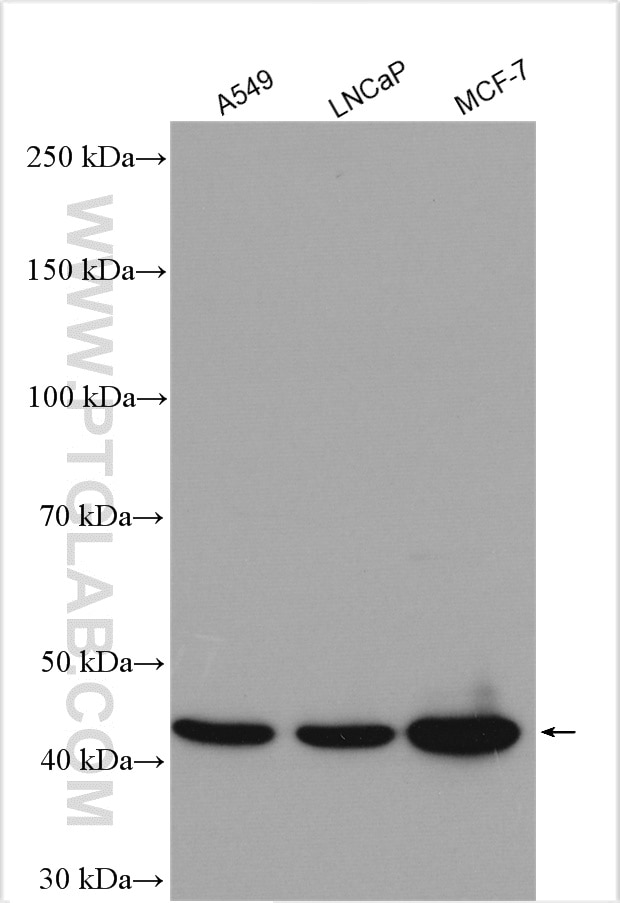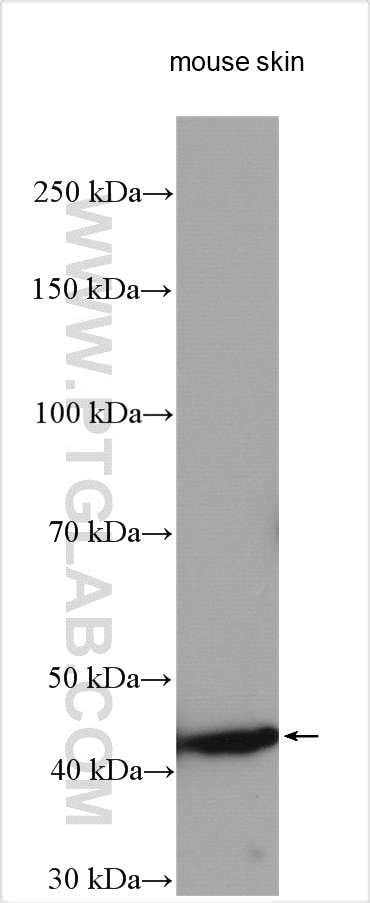SULT2B1 Polyclonal antibody
SULT2B1 Polyclonal Antibody for WB, ELISA
Host / Isotype
Rabbit / IgG
Reactivity
Human, Mouse
Applications
WB, ELISA
Conjugate
Unconjugated
Cat no : 29185-1-AP
Synonyms
Validation Data Gallery
Tested Applications
| Positive WB detected in | A549 cells, mouse skin tissue, LNCaP cells, MCF-7 cells |
Recommended dilution
| Application | Dilution |
|---|---|
| Western Blot (WB) | WB : 1:1000-1:4000 |
| Sample-dependent, check data in validation data gallery | |
Product Information
29185-1-AP targets SULT2B1 in WB, ELISA applications and shows reactivity with Human, Mouse samples.
| Tested Reactivity | Human, Mouse |
| Host / Isotype | Rabbit / IgG |
| Class | Polyclonal |
| Type | Antibody |
| Immunogen | SULT2B1 fusion protein Ag30209 相同性解析による交差性が予測される生物種 |
| Full Name | sulfotransferase family, cytosolic, 2B, member 1 |
| Calculated molecular weight | 365 aa, 41 kDa |
| Observed molecular weight | 41 kDa |
| GenBank accession number | BC034694 |
| Gene symbol | SULT2B1 |
| Gene ID (NCBI) | 6820 |
| RRID | AB_2918245 |
| Conjugate | Unconjugated |
| Form | Liquid |
| Purification Method | Antigen affinity purification |
| Storage Buffer | PBS with 0.02% sodium azide and 50% glycerol pH 7.3. |
| Storage Conditions | Store at -20°C. Aliquoting is unnecessary for -20oC storage. |
Background Information
SULT2B1 is a member of hydroxysteroid sulfotransferase (SULT) family that catalyzes sulfonation of hormones and other molecules. SULT2B1 encodes two isoforms, SULT2B1a and SULT2B1b, that differ only at their amino termini but have distinct biochemical properties as well as tissue distribution. The human fetal brain appears to only express the SULT2B1a isoform, while SULT2B1b is the predominant hydroxysteroid sulfotransferase expressed in human skin. Northern blot analysis revealed SULT2B1a has a limited tissue distribution in liver, adrenal and stomach, whereas SULT2B1b can be detected in a variety of hormone-responsive tissues including placenta, ovary, uterus, and prostate.
Protocols
| Product Specific Protocols | |
|---|---|
| WB protocol for SULT2B1 antibody 29185-1-AP | Download protocol |
| Standard Protocols | |
|---|---|
| Click here to view our Standard Protocols |



